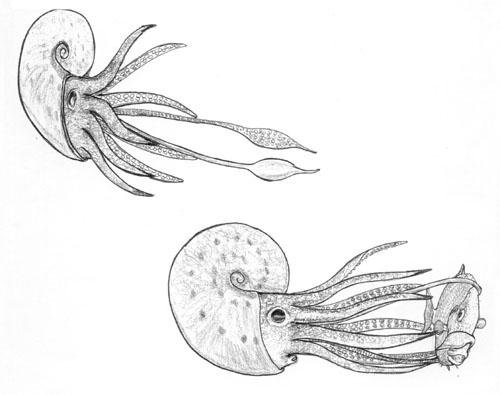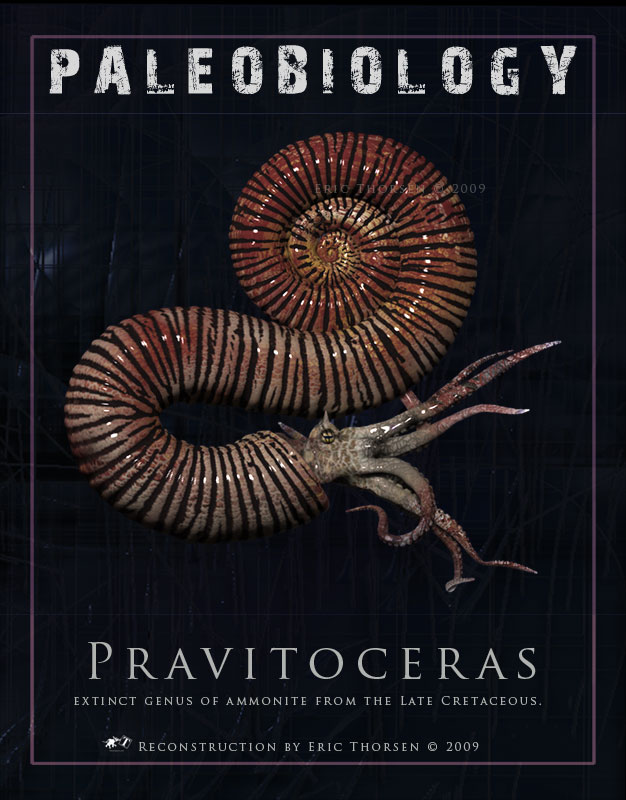[Recent Entries][Archive][Friends][User Info]
April 20th, 2013
| April 20th, 2013 | |
|---|---|
| 08:08 pm [industrialterro] [Link] |
Phylloceras Phylloceras is an extinct genus of ammonite. Phylloceratidae is the predominant family of the Phylloceratina with some 15 or more genera found in rocks ranging from the Lower Jurassic to the Upper Cretaceous. Members of the Phylloceratidae are characterized by smooth, involute shells with very thin walls. Many are covered with fine growth lines but are usually without ribbing. Sutures are complex with the major and minor branches of the saddles with phylloid or spatulate endings. The Phylloceratidae are probably derived from the Late Triassic Discophyllitidae by increasing the sutural complexity and evolving involute coiling. The Discophyllitidae in tern have their origin in the Ussuritidae, also known as the Monophyllitidae. The Phylloceratidae gave rise at or near the beginning of the Jurassic to the ancestral Lytoceratina, the early Lower Jurassic Peluroacanthitidae and Ectocentridae. The Phyloceratidae also gave rise at or near the beginning of the Jurassic to the Psilocerataceae which unites families of the Early Jurassic Ammonitina. Other Jurassic Ammonitina are derived from the Lytoceratina. Later, phylloceratids are said to have given rise to Cretaceous Ammonitina included in the Desmocerataceae, Hoplitaceae, and Acanthocerataceae. Sutures in the Phylloceratidae vary in complexity and are usually described on the basis of the saddles, which diverge to the front. Saddle endings may be double (diphyllic), triple (triphyllic), or quadruple (tetraphillic). Branching may be asymmetric. Intervening lobes are variably branched with thorn-like or spinose terminations as viewed in plan.
Ископаемые останки (1, 2, 3, 4):
Tags: Аммониты, Вымершие беспозвоночные, Мел |
| Time | Event |
| 08:49 pm [industrialterro] [Link] |
Placenticeras Placenticeras is an ammonite genus from the Late Cretaceous. Its fossils have been found in Asia, Europe, North and South America. Placenticeras, named by Meek, 1870, is the type genus for the Placenticeratidae, a family that is part of the Hoplitaceae, a superfamily of the Ammonitida. yup. Placenticeras has a very involute shell with slightly convex sides and a very narrow venter. Side are smooth or with faint sinuous ribs. Early whorls have umbilical tubercles that in later whorls appear higher on the sides. Earlier whorls normally have lower and fine upper ventrolateral clavi. Ornament weakens in the adult and the last whorl may be smooth. The suture is with numerous adventitious and autxiliary elements, with saddles and lobes that are much frilled.
Ископаемые останки (1, 2, 3, 4):
Tags: Аммониты, Вымершие беспозвоночные, Мел |
| Time | Event |
| 09:03 pm [industrialterro] [Link] |
Pravitoceras Pravitoceras is an extinct genus of ammonite. Nostoceratidae is a diverse family of heteromorph ammonites found throughout the oceans of the world during the Late Cretaceous. The nostoceratids are famous for the bizarre coiling of their shells. Many genera, such as Yezoceras, Ainoceras, Anaklinoceras, and some species of Bostrychoceras and Eubostrychoceras, display, as young shells at least, a helical coiling very similar to the shells of the related family, Turrilitidae. As adults, though, the coils then curve away from the axis of coiling, either as an oxbow-like curve around the juvenile coils as in Ainoceras and Anaklinoceras, or in a simple curved loop beneath the juvenile coils, as in Yezoceras. Other genera form loose coils, sometimes in a spiral, such as those of Madagacarites, Muramotoceras, Hyphantoceras, and the infamous Nipponites. The ecology of nostoceratids is the subject of continued speculation, as the bizarrely coiled shells have no streamlining, strongly suggesting that the living animals had extraordinarily poor swimming ability, if any ability at all. As such, experts and ammonite enthusiasts presume that the nostoceratids either floated passively in the water column, or were bottom-dwellers that may or may not have crawled on the seafloor. The nostoceratids, as with all other Cretaceous ammonites, perished during the Cretaceous–Paleogene extinction event.
Tags: Аммониты, Вымершие беспозвоночные, Мел |
| Previous Day | 2013/04/20 [Archive] |
Next Day |












